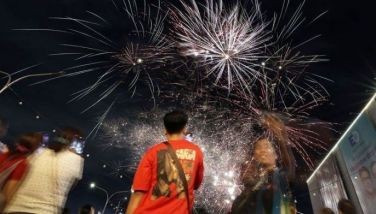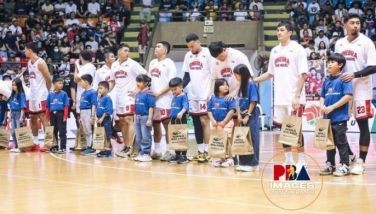From Osmeña reforestion project to experimental forest station: Potentials and implications
CEBU, Philippines - The feelings of eccentricity, fascination and serenity could be experienced when someone visits the forested area within Camp 7, previously under the Osmeña Reforestation Project. It could be one of the ideal places near Cebu City (about 25 km) where one could commune with nature and more importantly with His Divine Creator.
The presence of towering tree species and lush vegetation not only generates cool and fresh air but also provides a sustained life support system for other organisms. Moreover, it also offers tourist, religious and recreational spot, provides a living laboratory for students, and makes available avenue for researchers in the pursuit of scientific inquiries in the field of natural and environmental sciences.
The reforestation activities in the Osmeña Reforestation Project (ORP) dated back in 1916, being dubbed as one of the oldest reforestation projects in the country. The Osmeña Reforestation Project was originally a portion of a Friar Land Estate of Talisay and Minglanilla, Cebu, which the Philippine Government purchased from the Vatican during the administration of William Howard Taft, the first Civil Governor of the Philippines. During that time, ORP is considered as one of the premier reforestation projects in the country. The project went on for quite sometime until changes occurred when portion of the forest reserve under ORP was declared as Experimental Forest Station (EFS) by virtue of DENR Administrative Order No. 2004-51 dated 31 August 2004.
The Biophysical Resources
Floral Resources. There are 64 forest trees and associated species in the experimental forest. The leading species is mahogany which comprises 49.40% of all species in the EFS. The other top ten (10) species in terms of dominance are the following: mahogany, teak, gmelina, lumbang, lanutan, narra, robles, Benguet pine, banaba and Acacia auriculiformis. Other vegetations found in the EFS are the 6 species of bamboo with an aggregate area of 12 hectares and 4 species of rattan also with an aggregate area of 12 hectares.
The estimated cash value of the timber is P178,879,090.50.
Faunal Resources. Secondary data on the existing species composition was taken from the “Socio-economic Profiling and Environmental Study of the Four Protected Areas in Cebu Island†conducted by the University of San Carlos on October 2000. Based on the listed species, a total of 77 species of insects were recorded in Camp 7, five species of birds, three species of lizard, two species of amphibians, two species of bats and some fresh water fishes. Endangered endemic species Copsychus cebuensis locally known as siloy has been detected inside the Experimental Forest Station.
River and Water Sources. The Experimental Forest Station has a permanent creek called the ORP creek that traverses a certain portion of the northwestern side of the forest station with an intercepted length of 713.69 meters. It passes through the old Omeña Reforestation Project nursery near the Clonal Nursery and extends to the built-up areas of Camp 7. It has six (6) minor intermittent rivulets and three are on the upper portion, two in the middle and one in the lower portion.
Cave Resources. There are seven (7) white caves as called by the local people located at the northern portion of the Experimental Forest Station. Initial ocular inspection has revealed that some are being explored by local people for treasure hunting. Diggings and destruction of caves structures are noticed.
The Research, Development and Extension (RDE) Opportunities
There are existing infrastructures and research facilities within the Experimental Forest Station which can be used for the conduct of RDE activities. Moreover, there are also four-going projects/activities in the Experimental Forest Station as follows:
· Seed Production Areas/Seed Source of Mahogany and Narra Species for Production of Good Quality Planting Materials
· Clonal Propagation Nursery of Forest Tree Species
· Demonstration Plantations for 5-Bamboo and 4-Rattan Species
· Production of Quality Planting Materials for NGP with four (4) Peoples’ Organizations
Basic Research
· Carrying Capacity of Existing Resources in the Experimental Forest
· Hydrology Study of Various Tree Plantation
· Cave and Ecotourism Studies
· Carbon Sequestration Study of Various Tree Plantation
· Assessment of Faunal Population inside the Experimental Forest
· Stand and Stock Inventory
· Biology and Phenology Studies of Various Plant Species
· Tissue Culture Research
· Nutrient Cycling Studies of Various Tree Plantation
Applied Research
· Propagation of Premium Endemic Tree Species
· Forest Genetic Conservation Studies of Dipterocarp Species and Other Premium Tree Species
· Timber Stand Improvement
Development and Extension Projects
· Pilot Plantation and Genetic Diversity Conservation of Non-timber Wood Products (bamboo, rattan, nito, hinggiw, and banban)
· Pilot Plantation of Gum and Exudates inside the Experimental Forest
· Establishment of Medicinal, Edible, and Essential Oil Plant Orchards
· Sericulture Project
· Mushroom Culture under Forest Plantation
· Establishment of Banaba Orchard for Medicinal Leaf Production
· Propagation and Culture of Flowering Plants and Fruit Bearing Trees
· Establishment of Bambusetum and Arboretum of Potential Lesser Known Tree Species
· Poverty Alleviation of The Surrounding Communities in the Experimental Forest through Agroforestry System
· Establishment of Butterfly Gardens
Enterprise and Livelihood Project outside the Experimental Forest Station
The Ecotourism Potentials
Important natural resources in the area that have ecotourism potentials include, caves, birds and other fauna, river, endemic tree species, and the Environment and Natural Resources (ENR) technology demonstrations. The three (3) caves located west of the Training Center are ideal for spelunking activities. Notable species of trees located in the area are the Benguet pine, saraca, amherstia, and the dipterocarps such as tindalo and lanutan, among others.
Faunal species that can be sighted include monitor lizards, bird species including the Cebu Black Shama, butterflies, etc. A stretch of an intermittent river can also be found crisscrossing the area. This can also be tapped for river trekking activities. Meanwhile, the presence and implementation of RDE projects in the area can be tapped as show window for Environment and Natural Resources (ENR) technology. These include the bamboo and rattan plantations and clonal propagation/nursery and hedge garden, among others.
The Livelihood and Enterprise Potentials
It is important to recognize that the local community is the real day-to-day managers of the forest resour-ces upon which they defend.
They make decisions about how these resources will be utilized and these people have significant impact on the forest. It is important to involve them in any development undertakings as well as address their socio-economic concerns through livelihood and enterprise opportunities in order to garner their authentic participation. Livelihood and enterprise development must focus on commodities that have potential market and in harmony in nature.
These include production of quality planting materials, honeybee keeping, production of anthurium and other ornamental plants, vermicomposting, soft broom making, handicraft production, floor wax making, rag making and embroidery, among others. Other livelihood projects which are forest based may also be implemented. This could include goat production, bamboo production and bamboo furniture making, etc.
The Implications
The Experimental Forest Station, a transformed Osmeña Reforestation Project focused within the declared 123.4 hectares, remains potentially rich in natural resources. Its biodiversity in terms of flora and fauna is very unique and worthy for exploration and scientific research.
Moreover, the microclimate, the scenic beauty of mountains, the chirping of birds and insect during day and night, and the presence of white caves, mini waterfalls, Mananga river tributaries as well as the research facilities are just some of the added attractions of the site.
However, the natural resources of EFS are currently threatened by human exploitation. We need an iron hand and allies to protect the EFS, the living legacy of Osmeña Reforestation Project.
The task is enormous and seemed impossible to accomplish. Yet, if we can start doing something, then we can make a difference. Basically, doing the right thing at the right place and at the right time is the fundamental idea.
And we must start now … and at this very moment. St. Francis of Assissi once said, “Start doing what is necessary, then do what is possible and suddenly you are doing the impossible.†(FREEMAN)
- Latest

























